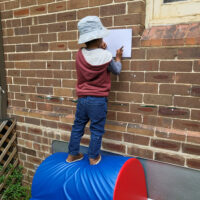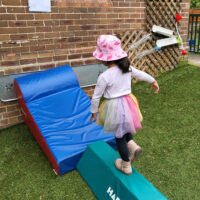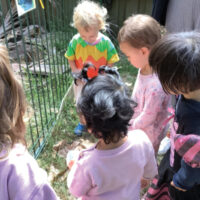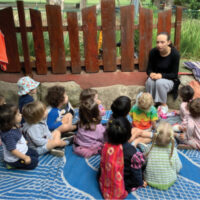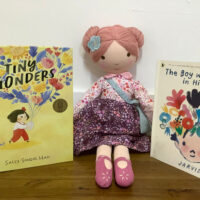Johnson House
Preschool
Story by Senior Occupational Therapist Justine
The children at Johnson House preschool have been practicing writing letters by combining both gross motor and fine motor together! After making their way across a small obstacle course, the children then worked on a vertical surface to trace some letters. Working on a vertical surface supports the progression towards dexterity and control as it encourages the proper wrist position (slight extension) for grasp and writing development.
Handwriting is a complex skill that develops over time. Tracing is a fundamental component of pre-writing skills, and pre-writing skills are essential for eventually developing the ability to hold and move a pencil fluently and effectively.
Murray House
Toddlers
Story by Centre Director Holly
The children in Murray House toddlers have been showing an increased interest in the weather and the world around them, so this morning we spoke about the rain. The children began by looking up at the sky, which was cloudy. We spoke about the kind of weather that clouds can bring, “We need to wear long pants,” one child told us. “It might rain,” said another.
I asked the children if they would like to make a rain catcher to collect some rain. We started by using an old milk bottle and cut it in half. I then asked the children if they recognised the special measuring tool. “A ruler!” a child exclaimed. We used the ruler to mark out points on the bottle. We then used numbers to show how much rain each point would measure. Together, we counted from one to six and added these to the bottle. Our rain catcher was ready, and the children had to find the perfect spot for it. We brainstormed, and decided that a place that was outside, away from trees and the shade sails, would be the best spot to catch the rain. The children chose a spot at the back of the yard, and we placed our rain catcher there. Now we wait for it to rain.
The children were very engaged in this experience, discussing weather patterns and using their mathematical skills to create the basic measuring device of the rain catcher. Experiences such as this allow the children to build an understanding of how mathematical concepts are used in the world around us, and how they are important for everyday use. The children are also developing their interest and awareness in weather events and the implications that certain weather events have on our daily lives. We will be avidly awaiting the next big down pour!
Robinson House
Story by Educator Denise
‘Flower-themed stories with Victoria’
The children in Robinson House and I engaged in a group time with a doll, who is named Victoria, dressed in flowers, and we read two flower-themed stories that express lessons about the beauty of the small wonders in our world and about showing kindness to others in times of need. These stories were introduced to the children a few weeks ago through free reading time and through previous group time experiences. Victoria was used as a visual model to encourage active listening behaviours such as keeping our hands in our laps and directing our visual attention to the person speaking.
After doing our Acknowledgement of Country, we first read ‘The Boy with Flowers in His Hair’, written by Jarvis. It tells us about the protagonist, whose best friend is a boy named David who has beautiful flowers in his hair. We get a glimpse into their close friendship and observe how well-liked David is. However, the situation changes when David suddenly loses the flowers in his hair, causing him to look scary and brittle. The protagonist feels empathy towards David and creates lots of paper flowers to replace the ones he lost. This kind act inspires their classmates to follow suit and David eventually grows back his flowers and regains his happy and friendly demeanour. The book teaches us a lesson about how an act of kindness can cause a positive ripple effect when offered to someone who is going through a hard time and that we have the choice to be kind to others.
We then engaged in a dialogic reading of ‘Tiny Wonders’, by Sally Soweol Han. Dialogic reading involves an adult and children having a dialogue around the text they are reading aloud together. ‘Tiny Wonders’ tells the story of a young girl named April who tries to bring colour back into her town. Inspired by her grandmother’s stories, April wishes for some dandelion seeds as they mean “to spread happiness” in the secret language of flowers. We are emotionally invested in her endeavour as she successfully manages to plant the seeds, allowing the flowers to bring colour back to her town and stir the wonder and curiosity of the other townspeople. During the reading, we discussed what things in nature make us stop and notice their beauty while helping to build our mindfulness and our sense of wonder and curiosity of the world around us. We also looked together at what secret message each flower conveys and further developed our understanding of the world around us.
After sharing the stories, I acknowledged the children’s attentiveness, and the children took turns to cuddle Victoria to end the group time. The children expressed lots of caring and nurturing behaviours toward the doll. It was lovely to observe the children passing the doll along so that everyone had a turn to cuddle her before resuming play.
